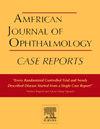Lupus retinopathy manifesting unilateral neovascular alterations: A case with 15 years of follow-up
Q3 Medicine
引用次数: 0
Abstract
Purpose
To report a rare case of lupus retinopathy, characterized by unilateral neovascular alterations and asymmetrical clinical progression.
Observations
A 32-year-old woman diagnosed with systemic lupus erythematosus (SLE) was referred to the ophthalmology department with decreased and blurred vision in the right eye. The patient was diagnosed with SLE at 31 years of age owing to cutaneous lupus, oral ulcers, and arthritis with a positive antinuclear antibody. Initial fundus assessment showed bilateral cotton wool spots predominantly in the right retina, and fluorescein angiography revealed nonperfusion areas exclusively in the right retina. Therefore, bilateral lupus retinopathy was diagnosed. Laboratory tests indicated the absence of concurrent antiphospholipid syndrome. The patient discontinued follow-up visits to the ophthalmology department for 1 year. Upon re-examination, a prominent neovascular membrane and vitreous hemorrhage were observed in the right eye, whereas cotton wool spots in the left eye resolved. The patient underwent lens-sparing pars plana vitrectomies two times. In the 15-year period after the vitrectomies, no recurrence of neovascular alterations in the right eye was noted.
Conclusions and importance
Although lupus retinopathy generally presents with similar severity in both eyes, the patient in this study demonstrated unilateral neovascular alterations and asymmetrical clinical progression. These findings indicate the requirement for careful monitoring of patients with asymmetrical lupus retinopathy, even in those without antiphospholipid syndrome.
狼疮视网膜病变表现单侧新生血管改变:15年随访1例
目的报告一例罕见的狼疮视网膜病变,以单侧新生血管改变和不对称的临床进展为特征。一位32岁的女性,诊断为系统性红斑狼疮(SLE),右眼视力下降和模糊,被转介到眼科。患者在31岁时被诊断为SLE,原因是皮肤红斑狼疮、口腔溃疡和关节炎,抗核抗体阳性。最初的眼底检查显示双侧棉絮斑主要位于右视网膜,荧光素血管造影显示非灌注区仅位于右视网膜。因此诊断为双侧狼疮视网膜病变。实验室检查显示无并发抗磷脂综合征。患者停止眼科随访1年。复查发现右眼新生血管膜突出,玻璃体出血,左眼棉絮斑消失。患者接受了两次保留晶状体的玻璃体切除手术。在玻璃体切除术后的15年期间,没有发现右眼的新血管改变复发。结论和重要性尽管狼疮视网膜病变通常在双眼中表现出相似的严重程度,但本研究中的患者表现出单侧新生血管改变和不对称的临床进展。这些发现表明需要仔细监测不对称狼疮视网膜病变患者,即使在那些没有抗磷脂综合征。
本文章由计算机程序翻译,如有差异,请以英文原文为准。
求助全文
约1分钟内获得全文
求助全文
来源期刊

American Journal of Ophthalmology Case Reports
Medicine-Ophthalmology
CiteScore
2.40
自引率
0.00%
发文量
513
审稿时长
16 weeks
期刊介绍:
The American Journal of Ophthalmology Case Reports is a peer-reviewed, scientific publication that welcomes the submission of original, previously unpublished case report manuscripts directed to ophthalmologists and visual science specialists. The cases shall be challenging and stimulating but shall also be presented in an educational format to engage the readers as if they are working alongside with the caring clinician scientists to manage the patients. Submissions shall be clear, concise, and well-documented reports. Brief reports and case series submissions on specific themes are also very welcome.
 求助内容:
求助内容: 应助结果提醒方式:
应助结果提醒方式:


